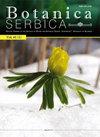应用RAPD-PCR和comet技术评价甜瓜砷致遗传毒性
IF 1.1
4区 生物学
Q4 PLANT SCIENCES
引用次数: 1
摘要
采用随机扩增多态性DNA -聚合酶链反应(RAPD-PCR)和彗星法研究了砷对黄瓜幼苗根和芽的遗传毒性。为此,将甜瓜幼苗在水培系统中暴露于浓度为0、100、200、300和400 μ M的砷酸盐[As(V)]中14天,以观察砷积累水平、生长参数的变化和DNA损伤。随着砷(V)浓度的增加,甜瓜幼苗的生长呈下降趋势。茎和根组织总砷积累呈剂量依赖性增加;然而,根的含量高于茎。在RAPD-PCR分析中,26条引物在对照苗中产生了128条条带,结果可重复且可评分。与对照相比,砷处理的幼苗的RAPD谱图发生了变化,包括新条带的丢失或出现。随着As(V)浓度的增加,两种组织类型的基因组模板稳定性(GTS)值均降低。在碱性彗星试验中,所有浓度的As(V)均出现DNA链断裂;此外,300和400 μ M砷(V)处理的DNA完整性损失更高。这些结果清楚地表明,基于dna的分子和细胞遗传学技术(如彗星测定)的结合可以作为重金属污染后植物遗传毒性的可靠评估方法。本文章由计算机程序翻译,如有差异,请以英文原文为准。
Estimation of arsenic-induced genotoxicity in melon (Cucumis melo) by using RAPD-PCR and comet assays
In this study, arsenic (As)-induced genotoxicity in the roots and shoots of Cucumis melo (melon) seedlings were investigated by using the random amplified polymorphic DNA - polymerase chain reaction (RAPD-PCR) and comet assays. For this purpose, melon seedlings were exposed to arsenate [As(V)] at 0, 100, 200, 300, and 400 ?M concentrations in the hydroponic system for 14 days to examine the level of As accumulation, alterations in growth parameters, and DNA damage. A reduction in growth with increasing As(V) concentration was observed in the melon seedlings. Total As accumulations in the shoot and root tissue increased in a dose-dependent manner; however, the level was higher in the roots than the shoots. In RAPD-PCR analysis, 26 primers gave reproducible and scorable results and produced a total of 128 bands in the control seedlings. Alterations in RAPD profiles, including the loss or appearance of new bands, were determined in the As-treated seedlings when compared to the control. The values of genomic template stability (GTS) were decreased by increasing the concentration of the As(V) in both tissue types. DNA strand breaks were observed in all the tested As(V) concentrations in the alkaline comet assay; furthermore, the loss of DNA integrity was higher with 300 and 400 ?M As(V) treatments. The results clearly indicate that the combination of DNA-based molecular and cytogenetic techniques (e.g. the comet assay) may be proposed as a reliable evaluation of genotoxicity in plants after exposure to heavy metal pollution.
求助全文
通过发布文献求助,成功后即可免费获取论文全文。
去求助
来源期刊

Botanica Serbica
Agricultural and Biological Sciences-Plant Science
CiteScore
1.40
自引率
12.50%
发文量
17
审稿时长
34 weeks
期刊介绍:
Botanica Serbica publishes original research papers on all aspects of plant, fungal and microbial biology research including the disciplines of microbiology, mycology, lichenology, bryology, flora, vegetation, biogeography, systematics, taxonomy, plant biotechnology, plant cell biology, plant ecology, environmental plant biology, forestry, genomics, horticulture, limnology, metabolomics, molecular biology, proteomics, virology, plant conservation and protection, and wildlife and ecosystem management.
 求助内容:
求助内容: 应助结果提醒方式:
应助结果提醒方式:


